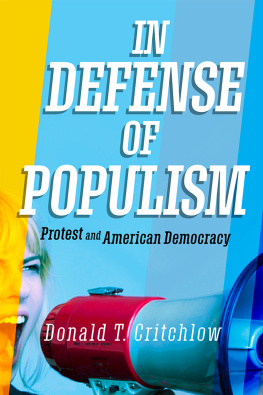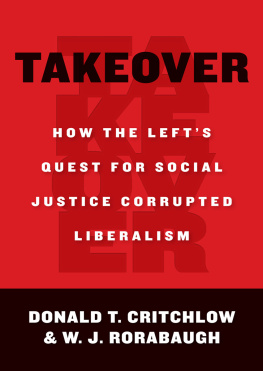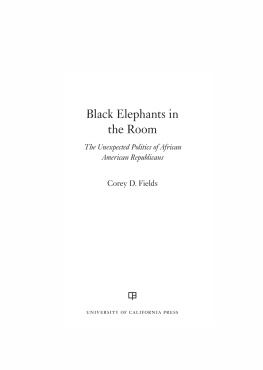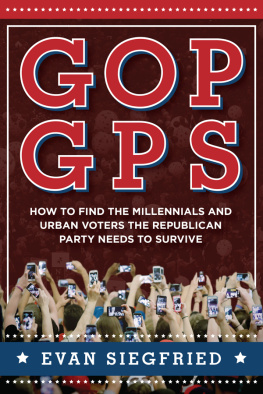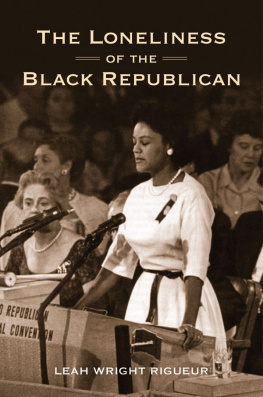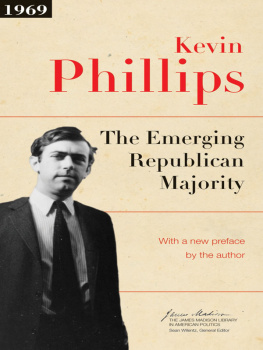Future Right
Forging a New Republican Majority
Donald T. Critchlow

St. Martins Press
New York
Thank you for buying this St. Martins Press ebook.
To receive special offers, bonus content, and info on new releases and other great reads, sign up for our newsletters.

Or visit us online at us.macmillan.com/newslettersignup
For email updates on the author, click here.
The author and publisher have provided this e-book to you for your personal use only. You may not make this e-book publicly available in any way. Copyright infringement is against the law. If you believe the copy of this e-book you are reading infringes on the authors copyright, please notify the publisher at: us.macmillanusa.com/piracy .
To Senator Jon Kyl and Steve Twist, Arizona Republicans, whom I consider good friends
Can Republicans forge a new majority party? The answer to this question is an emphatic Yes. This book explores how this is possible, but its not a certainty. Fortune plays a great role in politics, from selecting good candidates to campaign slipups, the mood of the electorate, and events beyond the control of politicians. Still, the conditions are there for Republicans to emerge as the dominant party of the future.
How is this to be accomplished? Future Right makes a twofold argument for creating a new Republican majority. The first argument is based on social and economic trends. The second argument is about political strategy, which focuses on the critical voter blocs necessary for a majoritarian party: women, minority, youth, older, middle-class, and religious voters.
The assumption that demographics favor Democrats as the party of the future is wrong. The Democratic base, an uneasy coalition of women, minorities, and young voters, is vulnerable to a Republican takeover. A close look at survey data shows that these groups are not uniformly liberal on many issues today, and in the future, as more women, minorities, and young enter the middle class, they will find Democratic Party identity politics both stale and inadequate.
Demographics alone are not political destiny, and socioeconomic trends are transforming the identity categories of race, gender, and youthwhich provides a rich opportunity for conservatives to create a new majority. Conservatives will need imagination and political acumen if they are to win over voters from these constituencies.
Democrats are quick to point out that whites, the base of the Republican Party, will be in the minority by mid-century. Current minority votersHispanics, blacks, and Asian Americansare voting overwhelmingly Democratic, and as young minorities reach voting age, they will only enlarge Democratic rolls. Young female voters are already voting Democratic, and there is no reason to foresee these voters aligning themselves with a graying, slowly dying Republican Party. Millennial voters overwhelmingly vote Democratic. They are progressives and see the Republican Party as the past, not the future.
The Left and its allies in the Democratic Party will continue to talk about the war on women, racism, and income inequality. It makes for good campaign rhetoric that beguiles their supporters into embracing policies and programs that imprison single unwed mothers in poverty, foster racism, and encourage the rhetoric of class warfare. The fact of the matter is that the older shibboleth categories of race and gender are changing as racial and ethnic intermarriage creates new Americans. More women are going to college than ever before, leaving school to become lawyers, doctors, and business professionals. Women have become corporate managers, executives, and leaders in their professions. The older rhetoric of the Left is clichd and does not represent the new American Dream that is being created.
While left-wing media pundits and politicians foresee the demise of conservatism in America, social trends favor a revived conservative movement. The Left confidently believes that changing demographics mean the slow death of conservatism; the reality is that if conservatives play it right, they can take advantage of these trends and win in 2016 and future elections. A seismic shift is coming in American society and culture, one that makes possible the creation of a new conservative majority.
In the last two presidential elections, Republicans lost minorities, young women, and youth in overwhelming numbers. Behind the reality of current voting patterns, which doubtless present a gloomy outlook for the Republican Party, there are trends that should not be overlooked. These social and economic trends reveal two major results: the meaning of race and the role of women in society are changing dramatically; and the retirement of the boomer generation, mostly white, will create new opportunities in the knowledge-based economy for racial and ethnic minorities, women, and the young. As the foundation of older identity politics is eroded by these trends, and as minority groups, women, and the young find opportunities in the new economy, becoming well-paid professionals, managers, and CEOs, their current vague concerns about social justice will give way to the real problems of how their taxes are spent; the size of government; economic growth; reducing the national debt; and national security. These issues play to the strength of the Republican Party.
As the old categories of race and gender break down, conservatives are well placed to send a message that invites average people to Imagine the New America. This message should be articulated by diverse voices that project an optimistic future as they tell of their successes in the land of opportunity and how conservatism represents the creators of the future. This message should be less issue-oriented and instead aimed at the average American voter fed up with the stale, divisive politics of the past.
A quick preview of some of these trends suggests how conservatives can take advantage of this new world.
Race: America is changing ethnically, and the old politics of race is going to be different in the future. Why? The answer is simple: intermarriage. Already Asian Americans are intermarrying with whites at a rate of more than 50 percent; Hispanic Americans are doing so at 35 percent; and African Americans are doing so at 15 percent. The children of these intermarriages tend to marry whites. The reconfiguring of race in America can be an advantage for conservatives who can win Hispanic and Asian Americans who rise financially and successfully in the twenty-first century. The conservative message should stress rewarding success and that taxes are wasted on big government.
Demographic trends show that race is being reconfigured. This transformation is occurring at striking speed, but old ideas about race will remain as culture lags behind social trends. The key to political success for conservatives will be an intermediate strategy of taking advantage of social and economic disparities that will occur among minorities, especially Hispanics, by breaking their long-standing ties to Democrats and the Left.
Asian Americans are at the top of the academic achievement heap. They have tilted Democratic in their voting, especially among the young. This voting pattern is a reversal from the late 1960s, when Asian Americans voted Republican. In many localities Democrats have been much better at candidate recruitment. The Asian-American vote can be regained by giving Asian-American leaders a key seat at the conservative table and by promoting Asian-American success storiesnot as an example of one races success, but of Americans success.



